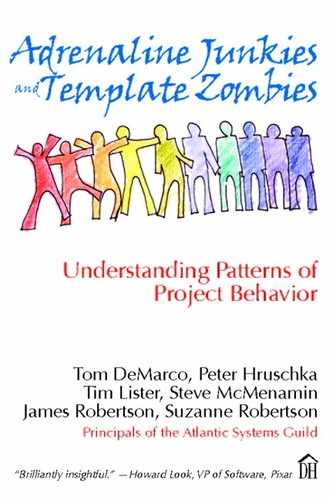18. Young Pups and Old Dogs
,
The organization with plenty of young people (in their twenties) is more vibrant than one filled with old farts.
You can be forgiven for reading the first part of the pattern and thinking, “We have reasonable numbers of young people in our organization.” But then you hit the parenthetical expression, and thought, “Uh, oh . . . not that young.”
When you find an organization with a critical mass of youngsters, the place is almost bound to be hardworking, upbeat, relaxed, and, in the best meaning of the word, fun. Everyone seems to be happy to be at work. Young people bring a sense of excitement with them. They haven’t been working full-time for very long, they are learning skills, and they are learning that they can become competent at difficult work. They are enthusiastic, they want to work, and best of all, they want to do a good job.
This keeps all of us Old Dogs on our paws and not snoozing in the corner. We have to run with the youngsters, and we become “younger” doing it. Though they are rarely represented at the top, young people are the rhythm section of the entire organization. They set the pace. Most importantly, they set the pace for learning. They’re young; they’re learning. That’s what they’re supposed to do.
For us Old Dogs, much of our knowledge comes from ten or more years ago and is now irrelevant. To stay at top-value, Old Dogs need the learning pace of Young Pups.
Contrast this with Very Old Dog organizations. Very Old Dogs are just about completely populated with folks in their forties, fifties, and on up. They have become this way from one of three causes:
• The organization is not growing, and there is little opportunity to hire youngsters. This happens frequently in places like government agencies where those who built large systems a decade—or several decades—ago are now maintaining them. For some people, it is a comfortable life, with good retirement and health benefits at the end of the trail. Managers in these organizations usually say it is hard to find a youngster willing to work there.
• The organization has decided to hire only experienced people. If this policy stays in place long enough, there are no Pups at all. “Fifteen years of XML experience required, an intimate understanding of JCL a plus.”1 Who would have these qualifications? Not a hot gun just out of a university.
1 JCL is intentionally inserted for the amusement of Ancient Dogs.
• The organization is downright unadventurous. It does not intend to deploy any new technologies that only young people know about. Nor will it embark on risky ventures that would require new and different talent. And in this kind of organization, the established managers do not want to be challenged by Young Pups who know things the Old Dogs don’t.
The obvious way of stopping your organization from becoming an Old Dog (or a Very Old Dog) is to hire youngsters. But not everybody can do that. You must have positions available, and you must be willing to invest in your newcomers. However, it is easy enough to consider getting some college co-ops to work part-time. There are also summer internships.
Dare we even mention high school students working after school?
